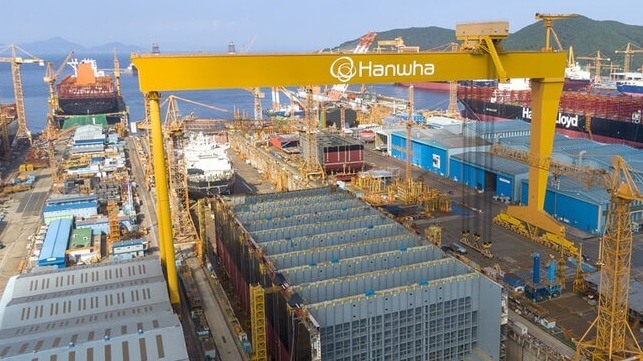Hanwha Ocean Sells Shares to Fund Maritime Defense Plans in U.S., EU
More than half of $1.5B capital raise will go for defense export initiatives, including "secure overseas production bases"

South Korean shipbuilder Hanwha Ocean (formerly DSME) is planning to raise a total of $1.5 billion through issuing new shares, the company confirmed Tuesday. The funds will go towards automating its shipyard complex, growing its defense product lines, and strengthening the firm's portfolio of green propulsion, offshore wind power and vessel autonomy solutions. The largest share - about half - will go towards overseas defense business aimed squarely at the U.S. and EU markets.
The announcement confirms market rumors of an impending capital raise. In an earlier filing Monday, Hanwha Ocean said that "no definite decisions have been made yet," and explained that it is examining several different options for new ventures, potentially including a capital increase. However, local media reports suggested that Hanwha Ocean had already picked five securities advisors to manage a capital raise of up to 2.5 trillion won ($1.9 billion). The final amount confirmed Tuesday was slightly lower at about 2 trillion won ($1.5 billion).
More than half of the capital raise will go towards enhancing Hanwha Ocean's defense portfolio, reflecting the focus area of new owner Hanwha Group (formerly Korea Explosives Company). About $680 million is earmarked for "secure overseas production bases and advanced technologies, targeting the global maritime defense market in the United States and Europe."
Foreign participation in these tightly-controlled shipbuilding markets typically requires localized production assets, like Australian-owned Austal USA and Italian-owned Fincantieri Marinette, both located within the United States and employing a U.S. workforce.
Another $230 million will be set aside for "smart yard" automation systems, which could reduce cost and help alleviate the workforce shortage that has plagued South Korean shipbuilding. Another $450 million would go for eco-friendly propulsion systems, and the balance of $150 million is set aside for offshore wind initiatives.
Contrary to market expectations, the firm did not earmark a portion of the new $1.5 billion capital raise for paying off corporate debt; as of the end of Q2, its debt to equity ratio stood at about 500 percent. In May, Hanwha Ocean announced a much smaller $100 million stock offering to be used for retiring debt.
The firm's market capitalization is about 7.6 trillion won, so the raise would represent about one quarter of its market value. Capital raises dilute the value of existing shares, and the market reacted: Hanwha Ocean's stock price shed about eight percent of its value in early trading.
